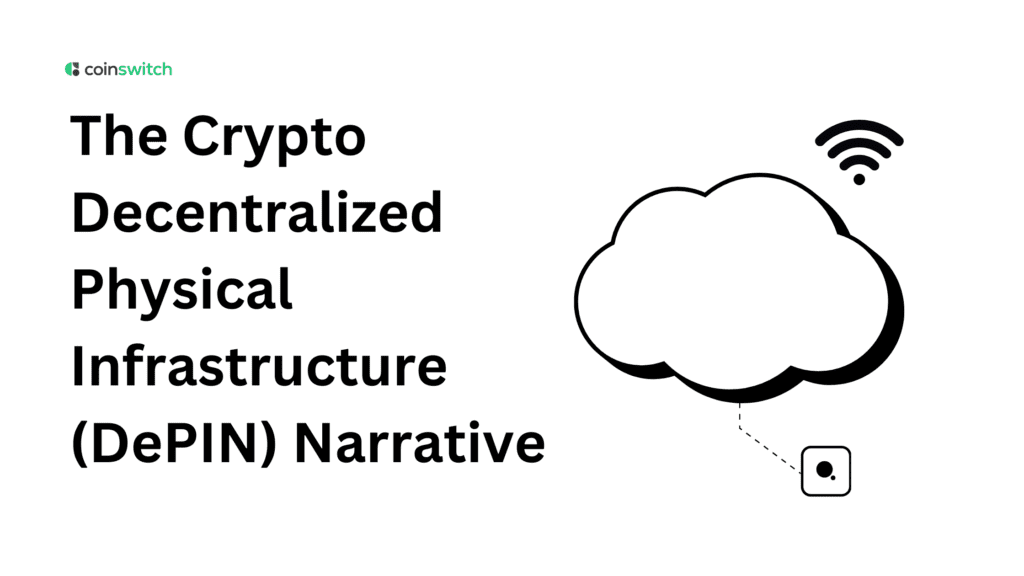What is DePIN in Crypto?
DePIN is short for Decentralized Physical Infrastructure Network. DePINs act as a bridge between the physical and digital worlds, ushering in a bold new phase in crypto. Instead of big companies building everything, individuals get to set up real-world devices like hotspots, sensors, and solar panels, and earn tokens while doing it. These networks run on community energy, not corporate control.
You plug in a device, provide a real service, like bandwidth, power, or storage, and the protocol watches your performance. The better your output, the more tokens you rack up. Every action gets logged on-chain, so everything stays visible and fair.
No, this isn’t theory. Projects like Helium pay people for sharing wireless coverage. Filecoin rewards folks for storing data. Render hands out tokens for computing power. They all follow the DePIN game plan: open entry, clear rewards, and complete community control.
In this model, power shifts to the users. You’re not just using the network, you’re building it, owning it, and steering it with your vote.
Understanding Decentralized Physical Infrastructure Networks (DePIN) in Crypto
A DePIN setup runs on real hardware, real services, and real rewards. Anyone with compatible gear and a crypto wallet can join in. You set up a device, it performs a task, and you earn tokens. Simple.
Each device becomes a node in a global network. Maybe it’s a Wi-Fi hotspot, a storage server, a GPU, or even a solar energy unit. As it works, it logs stats, uptime, output, and usage straight to the blockchain. Smart contracts take that info, verify it, and decide how much reward you’ve earned.
You don’t have to ask for permission or go through paperwork. Just install, connect, and start contributing. The system reads your performance and sends rewards directly to your wallet. You stay in control the whole time.
Governance is just as open. If you hold tokens, you help shape the network. Propose new features, vote on upgrades, or tweak performance rules. Smart contracts carry out the decisions without delay.
The growth feels natural. People install devices where they’re needed the most. If your town needs better internet, someone sets up a node and fills the gap. It grows faster than top-down corporate rollouts and adapts in real time.
Read More: Decentralized Identifiers (DIDs): The Ultimate Guide 2025
How Does DePIN Work?
Here’s how the system works:
- You install a device, like a router, GPU, or solar panel.
- DePIN tracks what it does, data moved, power delivered, uptime, or compute tasks.
- That data heads to the blockchain.
- The protocol checks it.
- Smart contracts handle the math and drop tokens into your wallet.
No paperwork. No delays. You plug in and get paid based on actual performance.
Your device works independently, but stays a part of a bigger system. Everything syncs on-chain, so results are transparent. You earn based on what your gear delivers.
At the same time, token holders run the show. They vote on reward rates, device standards, or where to expand next. That voting happens right on-chain and triggers updates without manual steps.
This cycle creates a powerful flywheel. More contributors grow the network. More users join. That brings in more data, more output, more services. Everyone benefits.
There’s no gatekeeping. No central authority picking favorites. Just real people, real devices, and real work.
What Are the Benefits of Decentralized Physical Infrastructure Networks (DePIN)?
DePIN flips the script on how infrastructure works. Here’s what makes it a big deal:
Open Doors for Everyone
No need for licenses or approvals. Got a wallet and a device? You’re in. Anyone around the world can join. That levels the playing field.
Token Rewards With Real Utility
You earn tokens that you can spend, stake, or use to vote. It’s not just about making money, it’s about shaping the system you’re helping to build.
Growth That Follows Real Demand
When a neighborhood lacks coverage, someone sets up a node. When data use spikes, more devices come online. Growth follows need, not meetings.
Automation From Top to Bottom
Smart contracts manage everything: rewards, performance checks, and rule enforcement. You don’t wait for human action. The system just runs.
Everything’s On-Chain
You can see what every device is doing, how much it’s earning, and where it’s located. That builds trust fast.
Global Redundancy
If one zone goes down, others keep running. Devices are everywhere, so the system stays strong.
You Get a Vote
Hold tokens? You have a say. Want higher rewards for rural nodes? Propose it. Your voice counts.
Easy Integration With DeFi
Use your tokens to lend, stake, or trade across DeFi apps. That adds flexibility and liquidity.
Read More: What Are Real-World Assets (RWAs)?
What Are the Challenges Facing DePIN?
Let’s talk hurdles. DePIN’s solid, but it needs to solve some real-world issues.
Hardware Logistics
You’re dealing with real gear, not code alone. Devices need setup, power, and sometimes repairs. Scaling can be tricky.
Reliable Data Feeds
The blockchain needs data from the physical world. That means solid oracles. If the data’s off, rewards get messy.
Laws and Rules
Different regions have different rules. Some zones may have strict policies on spectrum, power, or device types. Protocols have to work around those limits.
Smart Token Models
Too many rewards too soon? Inflation hits. Too few? No one joins. The balance takes work.
Coverage Gaps
When too many nodes gather in one place, other areas get ignored. Projects need incentives to spread things out.
Fair Governance
If whales control voting, smaller contributors lose influence. Protocols need systems that keep votes balanced.
Tech Compatibility
Cross-chain moves and liquidity sharing still have friction. Better tools will help connect tokens and services.
DePIN Sectors and DePIN Crypto Projects
DePIN isn’t just a concept anymore. It’s already out there, powering real networks. Let’s break down the key sectors where DePIN is making serious waves, and the standout projects leading the charge.
Wireless Networks
The Helium ecosystem (HNT) kicked things off by turning anyone into a wireless provider, upending the traditional wireless infrastructure model. Set up a hotspot at home, and you start earning tokens as your device covers local areas with connectivity. The more data transferred, the more you earn. It’s all logged on-chain and fully transparent.
Decentralized Storage
Filecoin (FIL), a decentralized data storage marketplace, built a system where people rent out unused storage space and earn tokens in return. You run a storage node, hold some encrypted data, and the protocol takes care of the rest, matching supply with demand and making sure the data stays online.
Compute Power
Render Network (RNDR) connects artists and devs with extra GPU power. Got an idle graphics card? Plug into the network and start earning by rendering 3D visuals and media projects.
Akash Network (AKT) gives developers access to a decentralized cloud infrastructure. Instead of renting from big tech, they tap into user-owned compute, all priced and distributed through smart contracts.
Clean Energy
Powerledger and SunContract let everyday users sell excess power to others. Whether it’s solar from your rooftop or wind energy from your microgrid, these platforms help energy producers find buyers directly, bypassing middlemen.
Mapping and Location Tools
Hivemapper (HONEY) rewards users for collecting street-level imagery. Drive around, film your route, and the network pays you. The result? A constantly updated, decentralized map of the world.
DIMO, the open-connected-vehicle protocol and network, tracks vehicle data, speed, fuel usage, and location. Drivers earn tokens as they share driving metrics with the network, unlocking smarter automotive services.
On-Chain GPS Systems
FOAM, a permissionless and autonomous proof of location-based DePIN network, takes geolocation on-chain. Contributors set up radio beacons, verify location signals, and earn tokens for keeping the system accurate and live.
Each of these projects sticks to the DePIN playbook, hardware, transparency, and real rewards.
Conclusion
DePIN represents a core shift in the crypto landscape. It merges physical infrastructure with the digital world. Contributors power the infrastructure globally and receive token rewards. Users tap services with community-led control. Governance resides with transparent token-holder frameworks. Infrastructure scales organically with demand.
Tokens align incentives across contributors and users. Networks expand as participants respond to usage. DAO-funded protocols vote for upgrades and token mechanics. Blockchain maintains audit trails, protocol data, and governance outcomes. DePIN unlocks a model where infrastructure moves beyond a reliance on centralized companies or capitalized rollout.
Instead, infrastructure becomes distributed, community-owned, and autonomous. Real-world services, from wireless to computing to energy, become accessible to anyone with hardware and wallets. Challenges remain in hardware support, verification, tokenomics, and regulation. Yet verification protocols, oracle networks, and legal frameworks evolve.
DePIN networks continue expanding across sectors as the narrative gains traction. Crypto redefines infrastructure ownership. The future of service networks may belong to individuals who build and maintain them, backed by token consensus and open governance.
FAQs
1. What is the DePIN narrative in crypto?
It describes a new paradigm where contributors deploy physical infrastructure and earn crypto rewards. Usage drives deployment. Governance stays open through token voting.
2. What is DePIN in crypto?
DePIN means Decentralized Physical Infrastructure Network. It structures systems where individuals operate real hardware and receive tokens based on validated contributions.
3. What is a decentralized physical infrastructure network?
It refers to networks of independently run nodes offering real-world services. Performance reports feed on-chain systems. Contributors get token rewards. Protocol governance remains community-led.
4. What is a decentralized system in crypto?
It signifies systems governed by smart contracts and token-holder voting. Control lies with participants, not centralized authorities.








